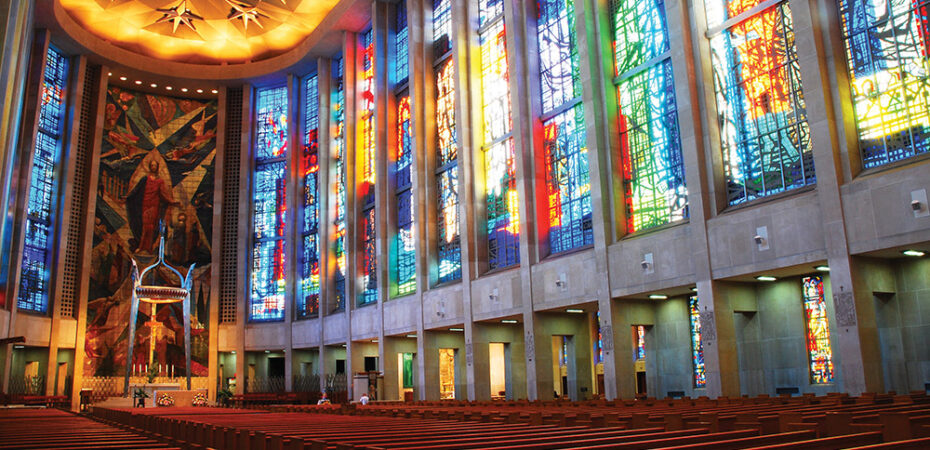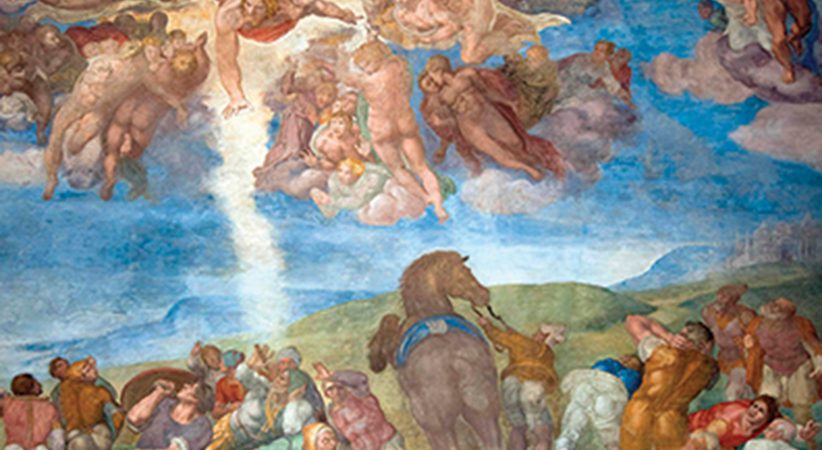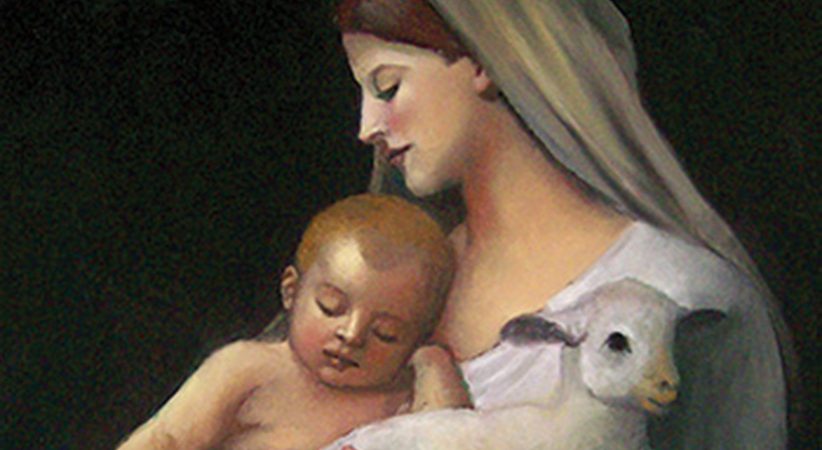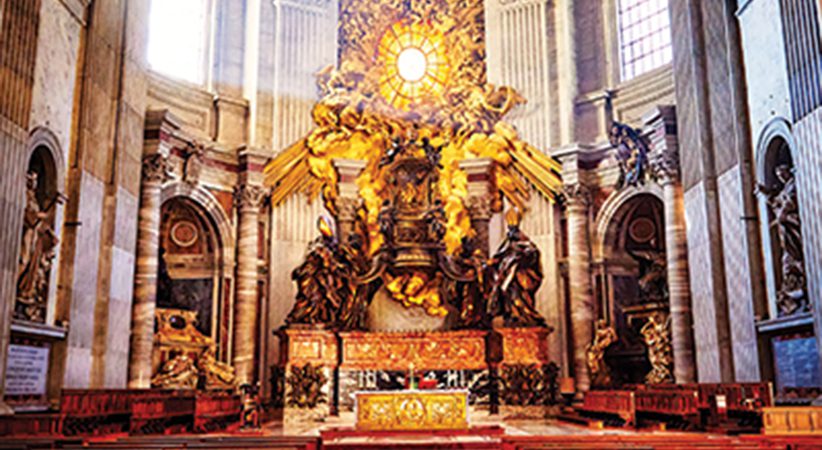Beauty and the Priest
Priests are mediators of the beauty that reflects God
Father Carter Griffin Comments Off on Beauty and the Priest
It was toward the end of a Sunday Mass at Mount St. Mary’s Seminary when the schola cantorum sang Mozart’s “Ave Verum Corpus.” Sitting among the concelebrants was the late Father Robert Zylla, OSC, a model of prayer, joy and wisdom for the young men like me in that chapel. His head was lowered in prayer as the motet was sung to perfection. When it was over, the elderly priest looked up toward the schola, a broad smile of gratitude on his face. Tears were streaming from his eyes.
That day, Father Zylla taught me more about the power of beauty to move souls than I had yet known. “Like gentle rain passing through the windows of the eyes,” Josef Pieper wrote, “beauty prompts the soul to sprout wings again, to soar to the dwelling of the gods, from where the soul originated.”
There is a need for precision today on the nature of beauty. Like truth and goodness, beauty has fallen victim to the relentless march of relativism. Most, I think, would deny the very notion of objective beauty. It is merely in the eye of the beholder, a personal opinion that can no more be discovered and embraced by all than your favorite flavor of ice cream.
Infinite Perfection of God
Beauty, however, is something real in the world, and not just a personal preference or way of seeing things. Aquinas, for instance, identifies three objective properties of beauty: integritas, proportio and claritas ― that is, integrity (or perfection), proportion and clarity (or brightness, radiance). Those are all things in the world, not just in our heads.
For us believers, beauty carries an even greater weight, since it is a reflection of the infinite perfection of God. “From the greatness and beauty of created things,” the Scriptures teach, “comes a corresponding perception of their Creator” (Wis 13:5, RSV). The Incarnation is proof that the material world, even the fallen material world, is precious in the eyes of God. The inner beauty of the Incarnate Son is reflected in the creation he came to redeem.
That is why we weep at the beautiful. Beauty is an icon through which we catch sight of God. It is a telescope through which we gain a glimpse of our heavenly homeland. Our souls are made for him, and we long for our true home. When the soul is pure, beauty causes us to tremble with joy even as we weep. Beauty evokes in the believer a deep homesickness, with all its potent mixture of pleasure and sadness, of gratitude and pain.
Edgar Allan Poe, in “The Fall of the House of Usher and Other Writings” (Penguin Classics, $13), compared our search for the eternal to “the desire of the moth for the star. It is no mere appreciation of the Beauty before us, but a wild effort to reach the Beauty above.” The tears, he writes, reflect “a petulant, impatient sorrow at our inability to grasp now, wholly, here on earth, at once and forever, those divine and rapturous joys of which through the poem, or through the music, we attain to but brief and indeterminate glimpses.”
Instruments of Beauty
Beauty is something that concerns us priests deeply, for several reasons. For one, when beauty is unmoored from truth and goodness, it is not only devalued; it can also grow wild. It can become an idol, drawing attention to itself instead of the source of all beauty. “Art is dangerous,” Iris Murdoch puts it, “chiefly because it apes the spiritual and subtly disguises and trivializes it.” It is only when art — all art, sacred and profane — is tempered by the humility of faith, by seeing itself in reference to the true and the good, that it can reach its real potential to move souls toward God.
That, then, is the second reason for priests to take beauty seriously. When art is channeled to the true and the good, as we have seen throughout the Christian era, it becomes a powerful instrument for the Gospel. It is a “pre-sacrament” disposing souls, when wisely directed, to receive grace. The deepest religious experiences are not purely intellectual. If we want to share the Gospel effectively, we will want to access more dimensions of the human being than the intellect. Beauty, whether in art, architecture, music or rhetoric in preaching, is a backdoor into the soul. Like St. John the Baptist, they can prepare the way for the Lord.
A third reason for priests to be instruments of beauty today is the disproportionate influence of screens in modern life. Digital technologies can be, and often are, employed well; but it cannot be forgotten that reality mediated through a screen is not actually reality. It can become an alternative, subjective reality that dazzles while dulling our appreciation for actual beauty. Even when we make an intentional effort to avoid being saturated in images, our life is filled with them. We are pickled in images. Exposing our people to beautiful art can enkindle in their hearts a thirst for true beauty in the world rather than a counterfeit approximation on a screen.
A fourth and final reason for us to be concerned about beauty is because we priests need it more than most. In our pastoral ministry, we come into contact with ugliness in all its worst forms — sin, doubt, failure, mediocrity. It is our calling to walk into those dark places and bring forgiveness, hope, light and relief. But we must never forget that some of that ugliness clings to us. Beauty can help offset its effects.
Charged with Mediating
The priestly vocation is fundamentally one of mediation. We are charged with mediating between God and humanity, carrying with us all the needs, hopes, fears and joys of our people to God and returning with his blessing, his mercy, his grace. One way of framing that work of mediation is through the three transcendentals of being. We mediate truth in our preaching and our teaching. We mediate goodness by administering the sacraments and guiding souls on the path of virtue. So how exactly do we mediate beauty?
The first step is to grow in our own appreciation for the beautiful. Reading books on beauty are a good place to start, such as John Saward’s “The Beauty of Holiness and the Holiness of Beauty” (Ignatius Press) and Father Thomas Dubay’s “The Evidential Power of Beauty” (Ignatius Press, $19.95). Take an in-depth tour at a local museum with a knowledgeable docent. Learn how to listen to and appreciate classical music. Read the Ignatius Critical Editions of great literature with their fine commentaries. Study up on the growing movement to restore beauty in architecture, especially Church architecture. There are many resources at our fingertips to enhance our capacity to experience genuine beauty.
A second step is to create an atmosphere of beauty around us, starting in the rectories. Rectories need not be drab nor dandyish — with a little help, perhaps from a parishioner with good taste, they can become bright, ordered, cheerful, beautiful places to live — without spending much money. Churches, of course, should also be places where every parishioner, regardless of wealth and status, can come into contact with true beauty. It is a matter of respect for the Lord who dwells there and of charity and justice for the people who worship there.
A third way to mediate beauty is to familiarize ourselves and our parishioners with the places of natural beauty nearby. Go on hikes with brother priests on a day off. Take the youth group to a lake for a day of fishing. A walk through the woods, with all our senses open, can sometimes do more for our spiritual lives than an hour of mental prayer. Jacques Philippe, in “Thirsting for Prayer (Scepter Publishers, $15.95), observes: “Contemporary man is often cut off from nature; he lives in a world that is reduced to a universe of tarmac, concrete and all kinds of screens. He is the prisoner of a fabricated world, a virtual world, the projection of his own fantasies, instead of being in contact with creation. As a result, he is sometimes cut off from God — and from himself.” We can offer a refreshing alternative.
Most importantly, though, we priests have the privilege of providing the richest experience of beauty on the planet in the sacred liturgy. In the Mass especially, and in Eucharistic Adoration, we not only mediate beauty, but we come into contact with the source of all beauty. When that divine encounter is promoted by a loving attention to detail, by beautiful music, vessels and vestments, by a beautiful church, by a clean and ordered sacristy and sanctuary, and by a reverent celebration of the sacred rites, we will bring more beauty into the world than all the great works of art together. Above all, we will draw souls into closer union with the one who is truth, goodness and beauty itself.
In mediating beauty, especially the beauty of the liturgy, we make our own the prayer of the psalmist. “One thing have I asked of the LORD, / that will I seek after; / that I may dwell in the house of the LORD / all the days of my life, / to behold the beauty of the LORD, / and to inquire in his temple.” It is a prayer that he never fails to answer.
FATHER CARTER GRIFFIN is the rector of St. John Paul II Seminary in Washington, D.C.
…………………………………………………………………………………………………………………………………………………..
Beauty Reflected in Sacred Art
“Sacred art is true and beautiful when its form corresponds to its particular vocation: evoking and glorifying, in faith and adoration, the transcendent mystery of God — the surpassing invisible beauty of truth and love visible in Christ, who ‘reflects the glory of God and bears the very stamp of his nature,’ in whom ‘the whole fullness of deity dwells bodily.’ This spiritual beauty of God is reflected in the most holy Virgin Mother of God, the angels, and saints. Genuine sacred art draws man to adoration, to prayer, and to the love of God, Creator and Savior, the Holy One and Sanctifier.” — Catechism of the Catholic Church, No. 2502
……………………………………………………………………………………………………………………………………………………





